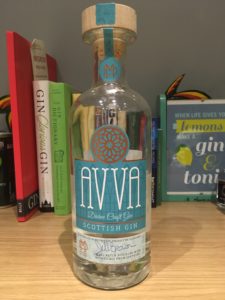 I’ve admired the bottle of Avva gin for a while, and truth be told it’s been sat on my shelf for nearly two years thanks to my old housemate bringing me a bottle home from one of her events. Based in the old cathedral city of Elgin (up the top near Lossiemouth) the Moray Distillery uses botanicals selected from the highlands and Speyside (including red clover, dandelion and nettle) to create their small batch gin. Avva means a respected grandmother from the Indian language of Dravidian, but in Hebrew it means to overturn or ruin – combined they make a nod to the traditional mother’s ruin reputation. Their still is made in Speyside and is named Jessie Jean after the founder’s grandmothers. The love of the local area continues into their branding, the label features the ‘rose window’ which is an idea of how the cathedral’s round window would have looked when it was still standing.
I’ve admired the bottle of Avva gin for a while, and truth be told it’s been sat on my shelf for nearly two years thanks to my old housemate bringing me a bottle home from one of her events. Based in the old cathedral city of Elgin (up the top near Lossiemouth) the Moray Distillery uses botanicals selected from the highlands and Speyside (including red clover, dandelion and nettle) to create their small batch gin. Avva means a respected grandmother from the Indian language of Dravidian, but in Hebrew it means to overturn or ruin – combined they make a nod to the traditional mother’s ruin reputation. Their still is made in Speyside and is named Jessie Jean after the founder’s grandmothers. The love of the local area continues into their branding, the label features the ‘rose window’ which is an idea of how the cathedral’s round window would have looked when it was still standing.
Month: January 2019
Fidra Gin
Note: I contacted Fidra to ask for a sample and a chat about where my family are from in Scotland, even though they’re based near the family home, I’ll tell you exactly what I think of the gin
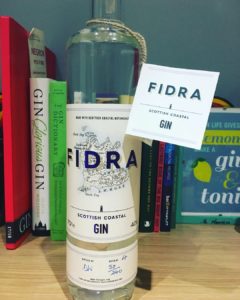 For those of you that know your Scottish islands, you might know of Fidra off of the coast of East Lothian. Fun fact – my Dad grew up near the border of East Lothian and we spent many a summer holiday eating ice cream on the beach in Musselburgh which is just along the coast. Emma and Jo set up Fidra Gin after their passion for gin developed and they wanted to showcase botanicals grown on the East Lothian coast. The botanicals used include sea buckthorn, elderflower, lemon thyme and rosehip, all handpicked from the local area. The proximity to the sea allows the botanicals to impart a slightly salty taste to the gin and their love for their area carries through to their branding, a beautiful tall, thin bottle with a label depicting the region. So, how does it taste?
For those of you that know your Scottish islands, you might know of Fidra off of the coast of East Lothian. Fun fact – my Dad grew up near the border of East Lothian and we spent many a summer holiday eating ice cream on the beach in Musselburgh which is just along the coast. Emma and Jo set up Fidra Gin after their passion for gin developed and they wanted to showcase botanicals grown on the East Lothian coast. The botanicals used include sea buckthorn, elderflower, lemon thyme and rosehip, all handpicked from the local area. The proximity to the sea allows the botanicals to impart a slightly salty taste to the gin and their love for their area carries through to their branding, a beautiful tall, thin bottle with a label depicting the region. So, how does it taste?
Biggar Gin
Note: I contacted Biggar for a sample and they kindly sent me one to try, as always I’ll let you know what I think.
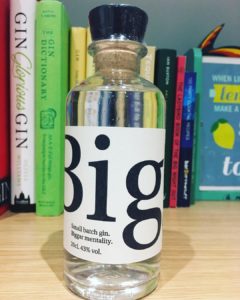 Biggar gin is one of the many new brands coming from Scotland, started by two brothers who focus on small scale production with big ambitions. They take their name from the town they grew up in, south of Glasgow and Edinburgh in the Southern Uplands and distil their gin at the famous Strathearn Distillery. Traditional botanicals juniper, coriander seeds, cardamom and orris root combine with rosehip, rowan berries and lavender. The idea behind the botanicals is to create a balance of flavours – sweet meets savoury, florals meet earthiness – which reflects the local landscape. So, how does it taste?
Biggar gin is one of the many new brands coming from Scotland, started by two brothers who focus on small scale production with big ambitions. They take their name from the town they grew up in, south of Glasgow and Edinburgh in the Southern Uplands and distil their gin at the famous Strathearn Distillery. Traditional botanicals juniper, coriander seeds, cardamom and orris root combine with rosehip, rowan berries and lavender. The idea behind the botanicals is to create a balance of flavours – sweet meets savoury, florals meet earthiness – which reflects the local landscape. So, how does it taste?
TBGC Strawberry & Balsamico Gin
Note: The team at Maverick Drinks sent me a bottle to try out on the blog, but as always I’ll let you know what I really think.
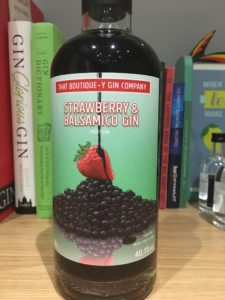 I’m going to be super honest up front: this does not sound like my cup of tea. That Boutique-y Gin Company have decided the best combination to match with gin is strawberry and balsamic vinegar. Now, don’t get me wrong, I like strawberries, I like balsamic vinegar, and I like the two together. But as a gin? They say the combination of the three works perfectly, a mix of syrupy, sweet and savoury together. They make it by creating separate distillates of black pepper, strawberry and Aceto di Balsamico tradizionale di Modena DOP aka the fanciest balsamic you can get your hands on and which is geographically protected a la Champagne. Not only does it have to be made in the province of Modena, but is has to also be aged for between 12 and 25 years in small barrels which gives the gin an oaky quality which balances the sweeter, fruity notes. They suggest having it on its own, with tonic or with prosecco – I’m a big fan of mixing sweeter liqueurs with prosecco, so perhaps this will be the winner for me.
I’m going to be super honest up front: this does not sound like my cup of tea. That Boutique-y Gin Company have decided the best combination to match with gin is strawberry and balsamic vinegar. Now, don’t get me wrong, I like strawberries, I like balsamic vinegar, and I like the two together. But as a gin? They say the combination of the three works perfectly, a mix of syrupy, sweet and savoury together. They make it by creating separate distillates of black pepper, strawberry and Aceto di Balsamico tradizionale di Modena DOP aka the fanciest balsamic you can get your hands on and which is geographically protected a la Champagne. Not only does it have to be made in the province of Modena, but is has to also be aged for between 12 and 25 years in small barrels which gives the gin an oaky quality which balances the sweeter, fruity notes. They suggest having it on its own, with tonic or with prosecco – I’m a big fan of mixing sweeter liqueurs with prosecco, so perhaps this will be the winner for me.
Fifty Pounds Gin
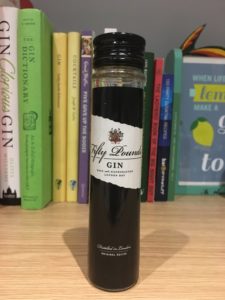 Fifty Pounds gin makes a bold claim. They say they are the “smoothest gin ever”. Distilled in south east London, the award winning gin is made in a small distillery and they triple filter it to achieve this smoothness. You might have seen Fifty Pounds gin before, their distinctive bottle is based on the first gin bottles from the 18th century, labelled with the batch and year it was made – possible due to the producing batches of only 1000 bottles. They keep their recipe secret but are quite open about their botanicals: Croatian juniper, coriander seeds, Spanish orange and lemon peel, and African grains of paradise amongst others. These are placed in the still with their neutral grain spirit and some water, are left to macerate then they gently heat them for the five hour distillation process. This is left for a minimum of three weeks which they say allows the essential oils from the botanicals to blend into the grain spirit. The final step in reaching their 43.5% ABV is to mix it with their neutral grain spirit and some pure water.
Fifty Pounds gin makes a bold claim. They say they are the “smoothest gin ever”. Distilled in south east London, the award winning gin is made in a small distillery and they triple filter it to achieve this smoothness. You might have seen Fifty Pounds gin before, their distinctive bottle is based on the first gin bottles from the 18th century, labelled with the batch and year it was made – possible due to the producing batches of only 1000 bottles. They keep their recipe secret but are quite open about their botanicals: Croatian juniper, coriander seeds, Spanish orange and lemon peel, and African grains of paradise amongst others. These are placed in the still with their neutral grain spirit and some water, are left to macerate then they gently heat them for the five hour distillation process. This is left for a minimum of three weeks which they say allows the essential oils from the botanicals to blend into the grain spirit. The final step in reaching their 43.5% ABV is to mix it with their neutral grain spirit and some pure water.
Chase GB gin
 Because I am very lucky, I have lots of lovely friends and today I’m drinking Chase Distillery‘s GB gin. Chase Distillery came about after potato farmer William Chase had enough of supermarkets pushing up prices and feeling detached from his customers, so used his potatoes to make crisps. Tyrrells crisps to be precise. Whilst making these, he stumbled upon vodka made from a potato spirit, and thought that seemed like something fun to experiment with. Flash forward four years and they released their first batch of vodka. Ten years on, they have built a new distillery on their farm in Herefordshire making their own vodka, which in turn is the base for their gin. They use 10 botanicals to make their vodka shine, including juniper (obvs), cinnamon, ginger, almond, cardamom, cloves and lemon. Chase have a big focus on sustainability, they create energy from a bio-boiler using orchard prunings, their potato waste fertilises the fields and feeds their cows and grow many of their fresh ingredients themselves. So, how does it taste?
Because I am very lucky, I have lots of lovely friends and today I’m drinking Chase Distillery‘s GB gin. Chase Distillery came about after potato farmer William Chase had enough of supermarkets pushing up prices and feeling detached from his customers, so used his potatoes to make crisps. Tyrrells crisps to be precise. Whilst making these, he stumbled upon vodka made from a potato spirit, and thought that seemed like something fun to experiment with. Flash forward four years and they released their first batch of vodka. Ten years on, they have built a new distillery on their farm in Herefordshire making their own vodka, which in turn is the base for their gin. They use 10 botanicals to make their vodka shine, including juniper (obvs), cinnamon, ginger, almond, cardamom, cloves and lemon. Chase have a big focus on sustainability, they create energy from a bio-boiler using orchard prunings, their potato waste fertilises the fields and feeds their cows and grow many of their fresh ingredients themselves. So, how does it taste?